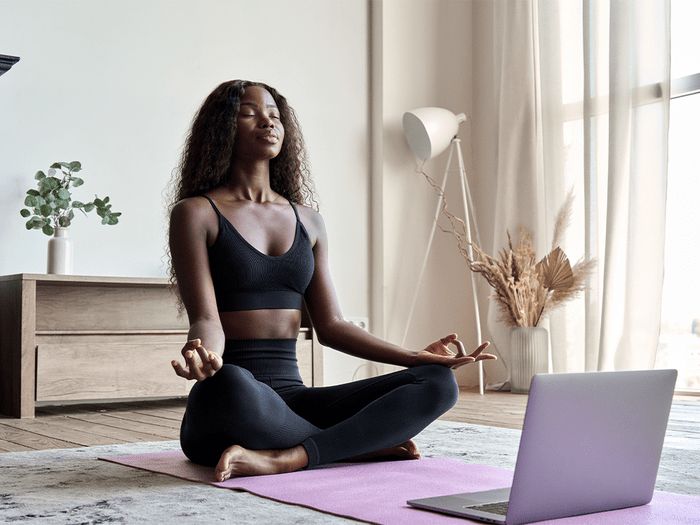My Phone Makes Me Anxious—Can a Meditation App Help?

Meditation apps are everywhere. They purport to bring mindfulness and a mental health boost straight to your phone. But, do they work?
Close your eyes. Relax your shoulders. Take a breath in. And breathe it all out.
My in-app instructor tells me to imagine my happy place. In my mind, I’m standing in front of a lake, while the water calmly rolls onto my toes. But when I open my eyes and pick up my phone at the end of the guided meditation class, I’m greeted by an onslaught of email, social media, text and other phone notifications—effectively killing my Zen.
Meditation apps like Headspace, and Calm, the one I’ve been using, have become ubiquitous. Over 100 million people have downloaded Calm, the most popular mindfulness app worldwide. In total, meditation apps are projected to be worth over US $2 billion by the end of 2022. And the pandemic has fuelled this growth: Downloads of the top 10 English-language mental wellness apps surged by 2 million in April 2020, at the height of the first lockdown.
The idea is quite simple: instead of venturing out to a meditation studio or joining in on your office’s Zoom-call Meditation Monday, you can tap your way to mindfulness by listening to a pre-recorded guided meditation. Some apps have classes that happen in real time, though most apps also have a huge back catalogue of pre-recorded classes that vary in length, focus and theme. To meditate using an app, all you need is a quiet space where you can sit in a comfortable upright position, then listen to the app’s narrator as they talk to you in hushed tones and urge you to bring awareness to your breathing.
Using meditation apps do have proven health benefits, and they’re similar to the benefits of meditating in-person with an instructor. One study, which focused on Headspace, another popular app, found that after using the app for 100 minutes, participants felt more positive emotions, according to the questionnaires used to measure these outcomes. Another study from 2018 found that learning mindfulness techniques through an app can help users monitor and accept stress, which leads to a greater ability to stay relaxed (this was measured through cortisol and blood pressure tests).
These apps have extended the benefits of meditation and mindfulness to more people—especially as the pandemic forced many of us to stay indoors (and many in-person meditation spaces to shut down, either permanently or temporarily). Memberships to IRL meditation studios can be pretty costly: prices vary from studio to studio, but generally, they’re at least $20 per class—similar to the cost of the average yoga class. But subscriptions to meditation apps are generally a lot more affordable. Calm, for example, costs $77 annually for an all-access membership. (There are also discounts for students, and some workplaces offer their employees a free subscription as a mental health benefit.)
Another major advantage to meditation apps is that they go wherever you go. If you’re travelling out of town, you can still meditate, even if you’re far from your usual studio. Or, if you’re a caregiver and can’t get away, you can meditate at home with your kids in the other room, or after they’ve gone to bed.
There are some downsides to mediation apps, however. Catherine Phillips, an assistant clinical professor in psychiatry at the University of Alberta and the founding director of the Mindfulness Institute in Calgary, says that the main benefit of meditating in real life is the presence of other people. While that may sound counterintuitive (isn’t the point to drown out distractions and the chaotic world around you?), Phillips insists that “a lot of the learning in mindfulness classes is through commonality of experience.” It’s powerful, Phillips says, to see other people doing the same thing you are, sharing in the experience and finding that same level of calm, together. “When class is over, people are invited to share their experiences, and you discover that you’re not the only one. This is part of meditation.”
Another downside, says Phillips, is that meditating can also bring out negative emotions, depending on the type of meditation. During an at-home meditation on your phone, when you’re all alone, there isn’t anyone there to help you talk through any negative emotions. (Phillips points to body scanning in particular, which is when you meditate while shifting awareness to specific body parts and paying attention to how they feel, which can be triggering to survivors of sexual assault.)
But the biggest challenge with meditation apps, at least in my experience, has been the fact that it’s an app. While I can certainly sit in my quiet room, crank up the volume in my headphones and close my eyes, the second my eyelids flutter open and I pick up my device to end the session, I’m brought immediately back to the thing that makes me anxious: My freaking phone—and all the pings or notifications that suck me into scrolling social media or checking my work email when I should be enjoying some screen-free time. There’s also a weird guilt I feel even having the apps on my home screen. I feel the need to check them, as I would my Instagram or emails, which makes me anxious that I’m not meditating enough, which makes me guilty that I’m not doing enough self-care, and the cycle continues. It’s a strange paradox to rely on the device that fuels my stress to get relief from that very same stress, and I’m not quite sure how to solve it yet.
Since downloading a meditation app and practicing mindfulness more often, I am, at the very least, more aware of the toxic relationship I have with my phone, and I do find it easier to compartmentalize those guilty feelings and push them aside. I just need to figure out how to somehow sustain that blissful, lakeside, post-meditative state a bit longer, instead of losing it the moment I exit the app and resume doom-scrolling.




